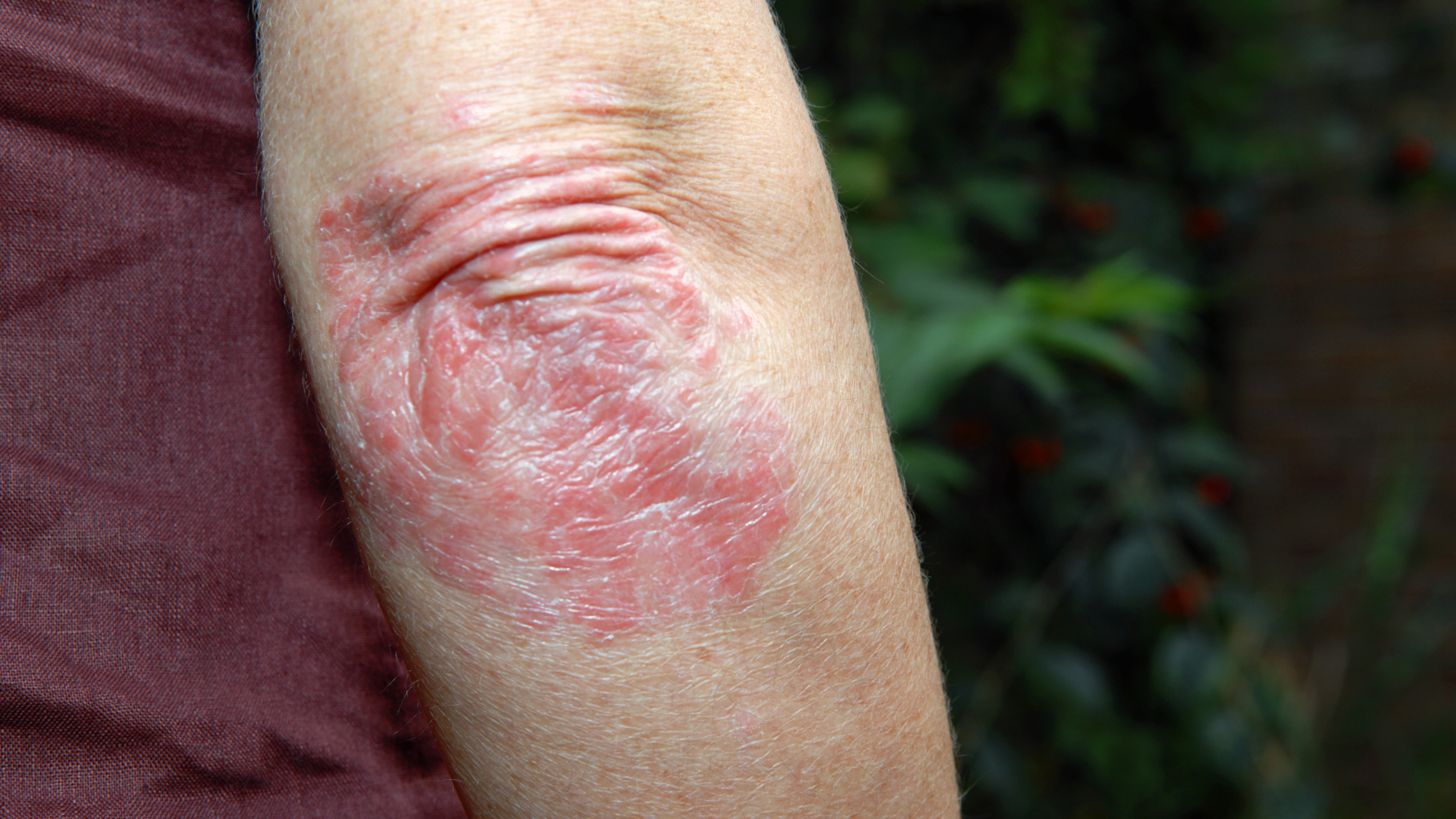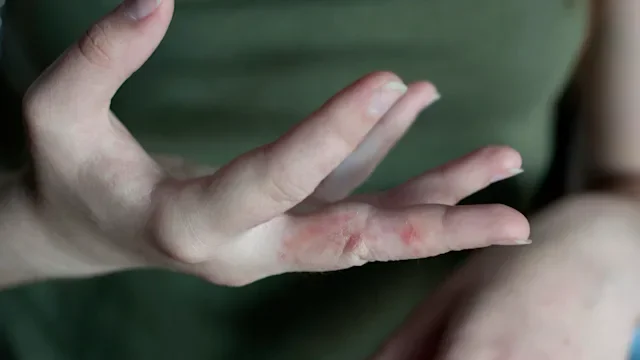Key takeaways:
Eczema and psoriasis are chronic skin conditions that can cause patches of red, violet, or brown flaky skin. People commonly confuse the conditions, but they have some noticeable differences.
Eczema is very itchy, and it usually affects the skin on the inside surface of the arm, behind the knees, and on the neck.
Psoriasis often looks like outlined red, brown, or violet areas covered with white or silver scales. It often shows up on the elbows and the knees, and it can also affect the joints.
The skin conditions eczema and psoriasis are often confused with each other. But there are differences to look out for. While eczema can be very itchy, psoriasis usually isn’t. Eczema also happens in the folds of the skin, whereas psoriasis happens over joints, like the knees or elbows.
That said, both conditions can be severe and affect your daily activities, mood, and quality of life. That’s why knowing how to tell them apart and getting proper treatment is so important.
Eczema and psoriasis affect different parts of the body
Eczema and psoriasis can affect any part of your skin. But they’re more likely to happen in certain spots. Knowing these common locations can help you tell them apart.
Search and compare options
Eczema
In older children and adults, eczema usually happens in the folds and creases of the skin. This means you often see eczema in these spots:
Psoriasis
Psoriasis tends to develop in opposite places than eczema. So, instead of the folds of the skin, psoriasis will often show up on the outer surfaces. You may see it on the:
Psoriasis and eczema start at different ages
You can develop eczema as a baby, a child, or an adult. But most of the more than 30 million people in the U.S. who have eczema are children.
You can also develop psoriasis at any age. But there are two time periods when you’re most likely to get psoriasis: between the ages of 20 and 30 years old, then between 50 and 60 years old. Unlike eczema, psoriasis isn’t common in babies and children.
Symptoms of psoriasis vs. eczema
Both eczema and psoriasis can itch, but eczema is usually worse. The itching in eczema may be so intense that you can’t sleep, or you scratch so much that your skin bleeds. Psoriasis can be mildly itchy, but it also causes a stinging or burning sensation.
Read more like this
Explore these related articles, suggested for readers like you.
How do eczema and psoriasis look different?
You can usually tell the difference between psoriasis and eczema based on how they look. Here are some key differences and what to look for.
Eczema pictures
Beyond where it shows up on the body, eczema has some specific characteristics to watch for. Here are some images to help.


Psoriasis
Beyond where it shows up on the body, psoriasis has some specific characteristics to watch for. Here are some images to help.


Triggers and causes
Eczema and psoriasis have different causes and triggers. Keep in mind that triggers are different for each person.
Eczema triggers
Several different factors cause eczema, including your genes and an overactive immune system. Some people with eczema have a mutation (change) in a gene for filaggrin. This is a protein that helps moisturize and keep the skin barrier intact. Without enough filaggrin, skin is more prone to inflammation.
These common triggers can also worsen eczema:
Extreme temperature changes or weather patterns
Stress (physical or mental)
Sweat and rubbing of the skin
Wool or other irritating clothing
Topical allergens, such as certain preservative and fragrances
Prolonged and frequent bathing with harsh soaps
Psoriasis triggers
Experts don’t know exactly what causes psoriasis. But your genes and an overactive immune system play a role. Psoriasis causes skin cells to grow faster than normal, which leads to thick plaques forming on the skin.
Like eczema, different triggers can make psoriasis worse. These triggers include:
Infection and illnesses, like strep throat
Certain medications, such as prednisone and lithium
Scratches, burns, and injuries to the skin (the Koebner phenomenon)
Lifestyle factors, like having a heavier weight and drinking alcohol
Certain foods, like sugar, alcohol, and gluten
Key differences between psoriasis versus eczema
The table below outlines the differences between the two commonly confused skin conditions.
| Eczema | Psoriasis | |
|---|---|---|
| How does it look? |
 VladimirKhodataev/iStock via Getty Images VladimirKhodataev/iStock via Getty Images |
 DaveBolton/E+ via Getty Images Images DaveBolton/E+ via Getty Images Images
|
| How does it feel? | Very itchy, painful, and dry | Sometimes itchy, can burn or sting |
| Where does it happen on the skin? |
|
|
| What are additional symptoms and risks? |
|
|
How to treat eczema and psoriasis
Eczema and psoriasis are treated in a similar way because they both use medications that lower inflammation in the skin. For mild eczema and psoriasis, this usually includes:
Over-the-counter (OTC) emollients to moisturize the skin
More serious eczema or psoriasis need stronger treatment. This includes pills to lower inflammation throughout the body, or new biologics that target specific parts of the immune system. For people with psoriasis and psoriatic arthritis, it’s also important to choose a medication that treats the joints in addition to the skin.
Here’s a breakdown of treatment options for eczema versus psoriasis.
| Eczema | Psoriasis | |
|---|---|---|
| OTC treatments |
|
|
| Prescription creams and topicals |
|
|
| Prescription systemic treatments |
|
|
| Procedures |
|
|
In general, practicing good skin care will help both psoriasis and eczema. Here are some skin care tips to keep in mind:
Keep your skin moist. Use a moisturizer regularly, and apply it right after you get out of the shower. If the air is very dry where you live, using a humidifier can also help.
Avoid irritating your skin. This means not showering or bathing with very hot water. And it also means not using harsh soaps, scrubs, or washcloths.
Avoid triggers that affect your skin. Learning what triggers your skin can help you avoid them and prevent psoriasis or eczema symptoms from becoming worse.
The bottom line
Eczema and psoriasis are chronic skin conditions that cause red, violet, or brown flaky skin. They’re commonly confused, but they have important differences. They look different, affect different parts of the body, and have different symptoms and triggers.
If you’re having skin rashes and think you may have eczema or psoriasis, talk with your primary care provider or dermatologist. They can help you understand the cause of your symptoms and develop a treatment plan with you.

Why trust our experts?



Images used with permission from VisualDx (www.visualdx.com).
References
American Academy of Dermatology Association. (n.d.). Stress: Is it a common eczema trigger?
Armstrong, A. W. (2017). Psoriasis. JAMA Dermatology.
Ballard, R. (2022). Is it eczema or psoriasis? National Eczema Association.
Dębińska, A. (2021). New treatments for atopic dermatitis targeting skin barrier repair via the regulation of FLG expression. Journal of Clinical Medicine.
Elmets, C. A., et al. (2020). Joint AAD-NPF Guidelines of care for the management and treatment of psoriasis with topical therapy and alternative medicine modalities for psoriasis severity measures. Journal of the American Academy of Dermatology.
Ji, Y., et al. (2019). Koebner phenomenon leading to the formation of new psoriatic lesions: Evidences and mechanisms. Bioscience Reports.
Murota, H., et al. (2019). Why does sweat lead to the development of itch in atopic dermatitis? Experimental Dermatology.
National Eczema Association. (n.d.). Eczema stats.
National Psoriasis Foundation. (2022). Causes and triggers.


















